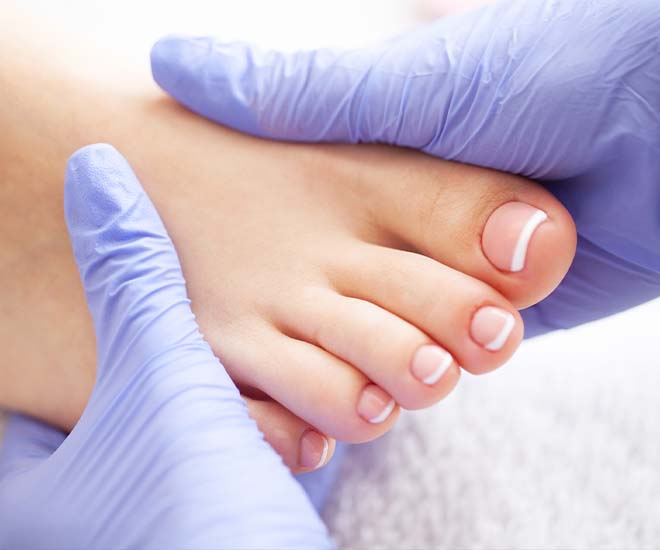
Get ingrown toenail care
What is an ingrown toenail?
Ingrown toenails are a common condition occurring when the corner or side of a toenail grows into the skin of your toe. While ingrown toenails usually affect the big toe, they can happen to any of your toes.
Most ingrown toenails can be treated at home, but sometimes they may need medical attention. If you have an ingrown toenail that’s causing severe pain or complications, our podiatrists can help.
Ingrown toenail symptoms
When you have an ingrown toenail, you may have symptoms including:
- Pain in your toe (on one or both sides of your toenail)
- Redness around your toenail
- Swelling around your toe
More serious ingrown toenails may result in an infection of the tissue around your toenail. If you have an ingrown toenail infection, you may experience:
- Severe discomfort
- Redness that seems to spread
- Pus or drainage from your toenail
Ingrown toenail risk factors
There are certain behaviors, genetics and risk factors that can increase your chances of an ingrown toenail. These include:
- Diabetes: People with diabetes or another condition that causes poor blood flow to the feet have a higher risk of an ingrown toenail infection. If you have diabetes, check your feet regularly for injuries, including cuts, scrapes, calluses, corns and ingrown toenails. These injuries may cause further complications — call your doctor if you notice slowly or improperly healing injuries.
- Improper footwear: If you wear shoes that crowd your toes, you may experience an ingrown toenail. Make sure your shoes have enough room to move your toes, but that they aren’t so loose your feet slide around.
- Injuries: Injuring your toenail suddenly or repeatedly can cause it to grow in a different way, and that can increase your risk of developing an ingrown toenail.
- Other risk factors: Poor foot hygiene, curved toenails or even cutting your toenails too short can result in an ingrown toenail.
Treatment for ingrown toenail
Our podiatrists are skilled at treating ingrown toenails to help you find relief from pain and discomfort. Treatment for ingrown toenails may include:
- Lifting the nail edge, which will help your nail grow properly. A piece of cotton or a splint placed beneath your toenail can help it grow above the skin. You’ll need to monitor and clean your toenail daily at home and may need to replace the splint or cotton until your ingrown toenail grows back properly.
- Trimming or removing the ingrown portion of the nail, which can help relieve your pain and allow your toenail to grow back normally. During this procedure, your doctor may numb your toe and then trim or remove part of your ingrown toenail.
- Removing a portion of the nail and underlying tissue, which can treat recurring ingrown toenails. In this procedure, your doctor will remove a piece of your toenail as well as some of the tissue of the nailbed beneath it. In some cases, the part of your toenail that was removed may not grow back. In severe cases, permanent nail removal may be required.
Podiatry care at Geisinger
- Comprehensive podiatry care: Get treatment for a wide range of foot conditions, from common foot pain to complex wound management. Our podiatrists will work with you to create a custom treatment plan and with doctors in other specialty areas, including orthopaedics, to make sure you get the care you need.
- World-class care, close to home: With locations throughout central, northeast and west-central Pennsylvania, our experienced podiatry team provides evaluations, consultations and comprehensive care. We offer leading-edge treatment options and tailored-to-you care backed by the expertise and innovation of a nationally renowned health system.
- Orthotic care: Our orthotics specialists provide custom braces and shoes that help treat several types of foot and ankle pain, foot complications related to diabetes and more. Orthotics offer treatment devices for people of all ages and is just one of the ways we help runners and other athletes take care of their feet.
